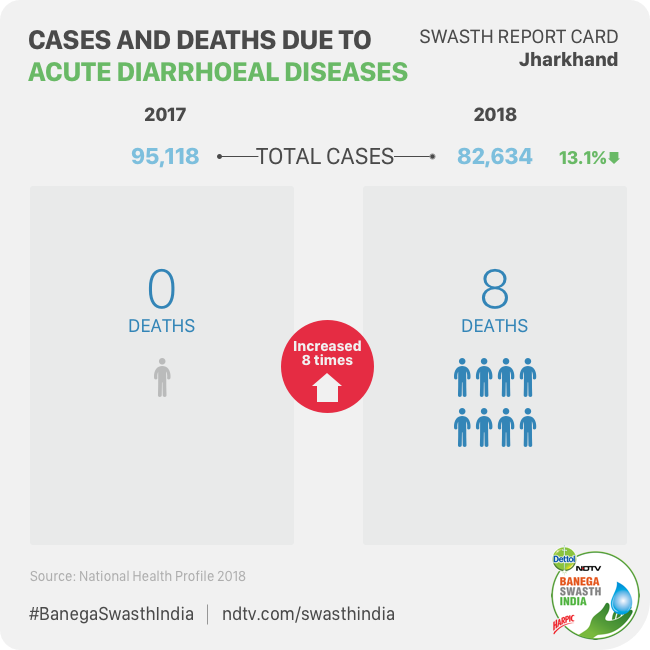New Delhi: Jharkhand’s health crisis hits home in the form of poor nutrition and low child survival rate. In 2017, around 52 infants died over a period of 30 days at Jamshedpur’s Mahatma Gandhi Memorial Medical College hospital due to malnutrition. According to the National Family Health Survey (NFHS) 2015 data, analysed by the International Food Policy Research Institute in New Delhi, Jharkhand’s Infant Mortality Rate was considered worse than most of the African nations. A recent Child Well-Being Index (developed by NGOs World Vision India and IFMR LEAD), released this year also listed Jharkhand as one of the bottom performing states. The index mentioned poor nutrition and low child survival rate as the main cause of the state poor performance.
Here’s a quick lowdown on Jharkhand’s health parameters as stated by the National Family Health Survey (2015-16), which gathered information from the 25,723 households, 29,046 women, and 3,820 men:
Also Read: Only 9 Per Cent Children Get Nutritious Food: Union Minister Smriti Irani
Here’s a look at Swasth Report of Jharkhand and its performance on health indicators:
- Infant Mortality Rate Over The Years Show A Downward Trend, But Still A Cause Of Concern: According to the National Family Health Survey (NFHS) 4, infant mortality rate (IMR) — per 1,000 live births in Jharkhand saw a decline of whooping 36.2 per cent with IMR in 2015-16 being 44 and 2005-06 being 69. But the IMR of Jharkhand still remains high as compared to India’s IMR in the year 2015-16, which was at 41. Moreover, Jharkhand’s IMR is also worse than the African nation of Ethiopia (41).
- Jharkhand’s Under-Five Mortality Rate (U5MR) Saw A Decline Of 42 Per Cent In The 10 Year Period Between 2005 and 2015: According to NFHS 4, Jharkhand’s under-five mortality rate (U5MR) (per 1,000 live births) is at 54 – down from a whopping 93 in 2005-06. That is a drop of 42 per cent. In the same period, India’s U5MR fell by about 32 percent [50 per 1000 live births in 2015-16, down from 74 per live births in 2005-06].
- Malnutrition, Still A Battle In Jharkhand: Over the course of 10 years, not much has changed in the state. Stunting of children under 5 years saw a decline of mere 4.5 per cent – from 49.8 per cent in 2005-06, it declined to 45.3 per cent. In the same time period, nationally stunting saw a decline from 48.0 (2005-06) to 38.4 (2015-16), which is 9.6 per cent.Whereas, when it comes to underweight statistics (low weight-for-age), Jharkhand saw a decline from 56.5 per cent in 2005-06 to 47.8 per cent in 2015-16. But the state is still far from the national average which is at 35.8 per cent (2015-16) down from 42.5 per cent (2005-06).Not just NFHS, as per the recently released Comprehensive National Nutrition Survey, Jharkhand has the highest number of underweight children at 42.9 percent, followed by Chhattisgarh at 40 percent and Bihar at 38.7 percent.
In wasting, the state saw a downward trend of 10.2 per cent – from 32.3 per cent in 2005-06 it declined to 29 per cent in 2015-16. But the good part is that it still saw a downward trend because in India, wasting rate saw an increase by 1.2 per cent – from 19.8 (2005-06) the figures increased for the country to 21.0 (2015-16).
- Statistics Of Anaemia Among Children and Adults Show Very Less Decline: When it comes to Anaemia, Jharkhand saw a decline of mere 0.4 per cent – from 70.3 per cent (2005-06) to 69.9 (2015-16) in children age 6-59 months. Whereas, in women, the decrease was from 69.5 (2005-06) to 65.2 (2015-16), which is 4.3 per cent.
Nationally, the average decrease for children suffering from anaemia is 10.8 per cent as per the NFHS4 survey and women is 2.2 per cent for the same time period.
According to the Nutrition Atlas which has been prepared by the Hyderabad-based National Institute of Nutrition, Jharkhand is in top 15 Anaemic states of India with a higher percentage of anaemic women than the national average of 53.1 per cent. Jharkhand is at 65.2 per cent followed by West Bengal 63.2%, Haryana 62.7%, Bihar 60.3%, Andhra Pradesh 60%, Telangana 56.7%, and Tamil Nadu 55.1%.
- Diarrhoeal Disease Deaths Saw An Upward Trend, From 0 to 8: According to National Health Profile 2019 report, Diarrhoeal disease deaths in the state in 2017 were 0 whereas in 2018 it increased to 8. Moreover, out of the total cases of Diarrhoea in India in 2018 (13,1M,94,775) Jharkhand contributed less than 1 per cent with 82,634 diarrhoea cases.Also Read: Swasth Report Of Uttar Pradesh: India’s Most Populous State Grapples With Anaemia Among Women, Child Wasting And Diarrhoea
Note: NFHS-4 fieldwork for Jharkhand was conducted from 9 April 2016 to 4 December 2016 by Development & Research Services Pvt. Ltd. (DRS) and gathered information from 25,723 households, 29,046 women, and 3,820 men.
Also Read: The Crisis Of Diarrhoea In India






















